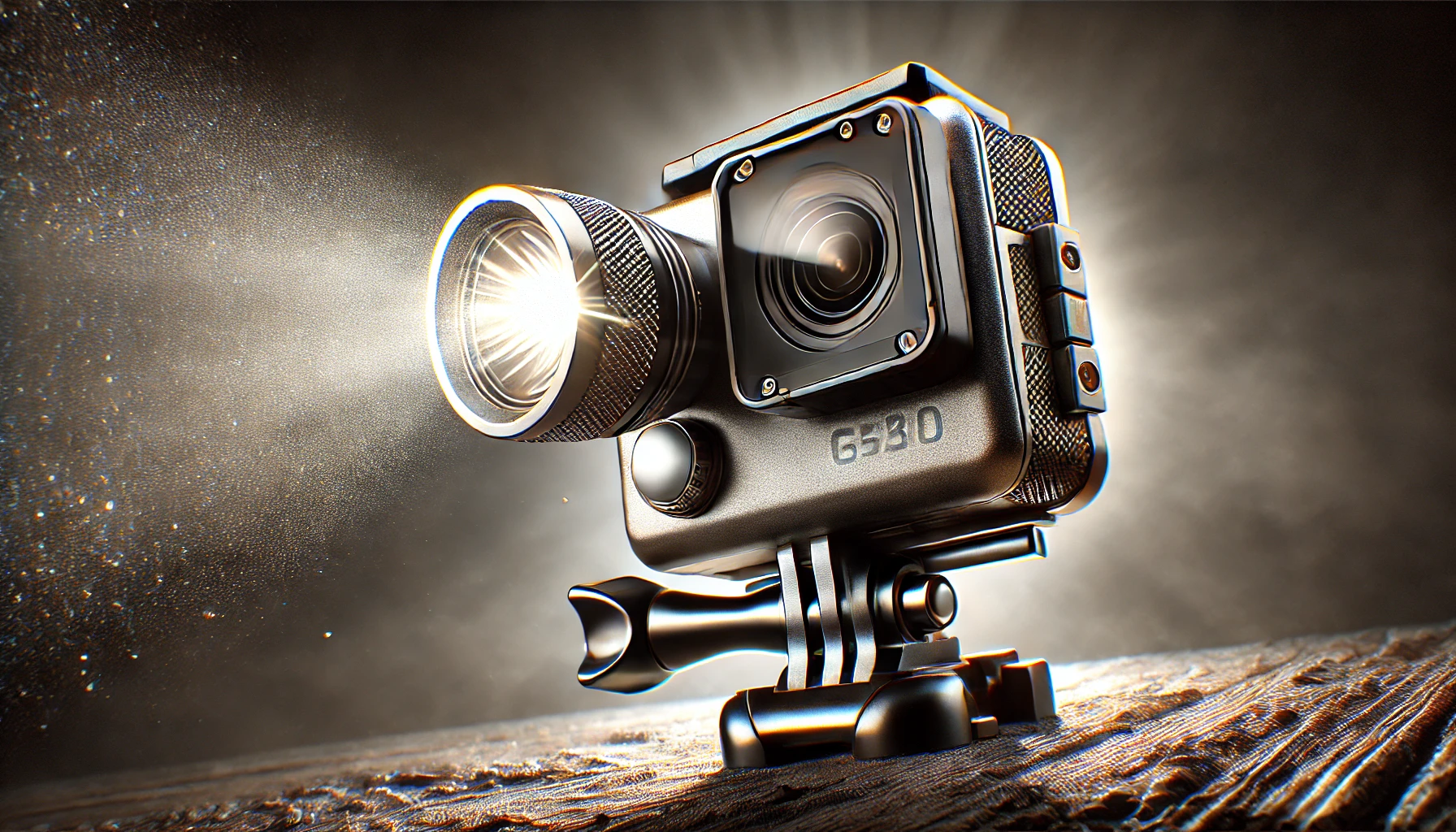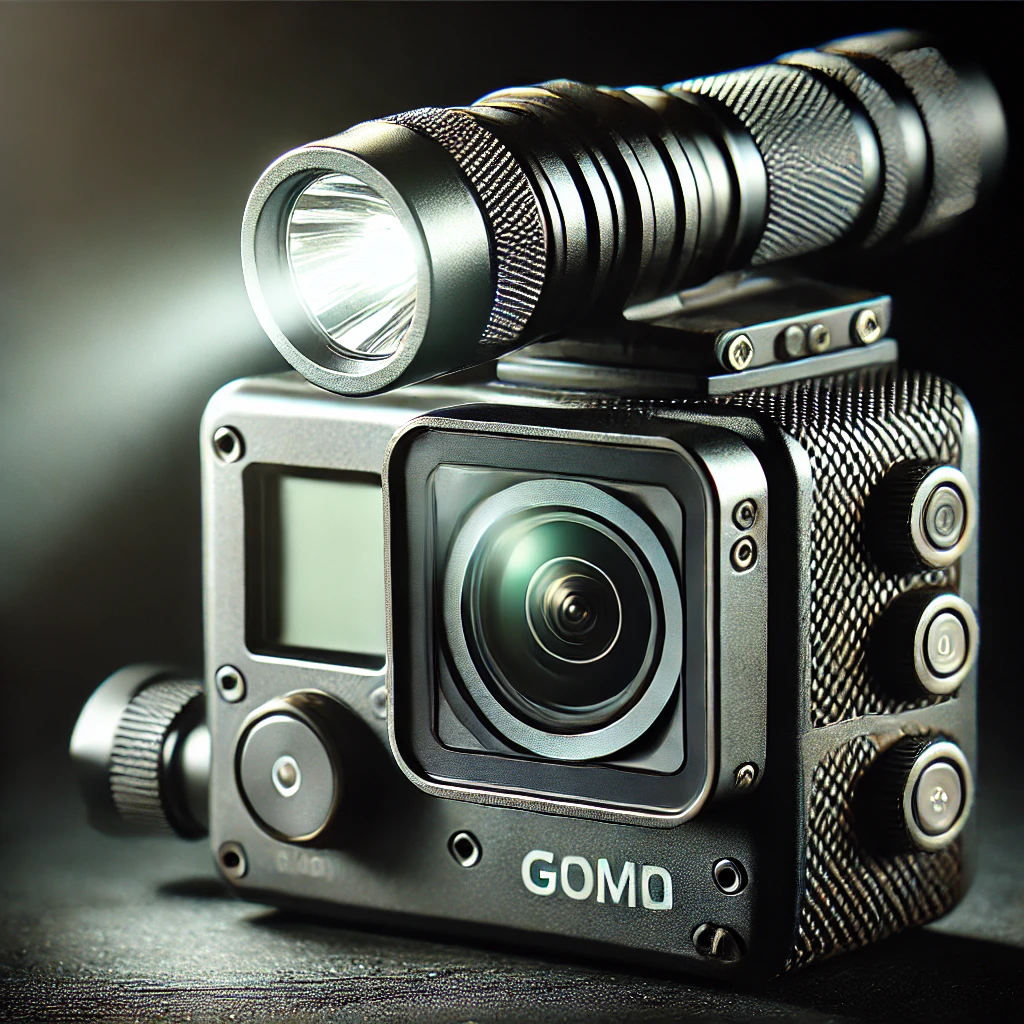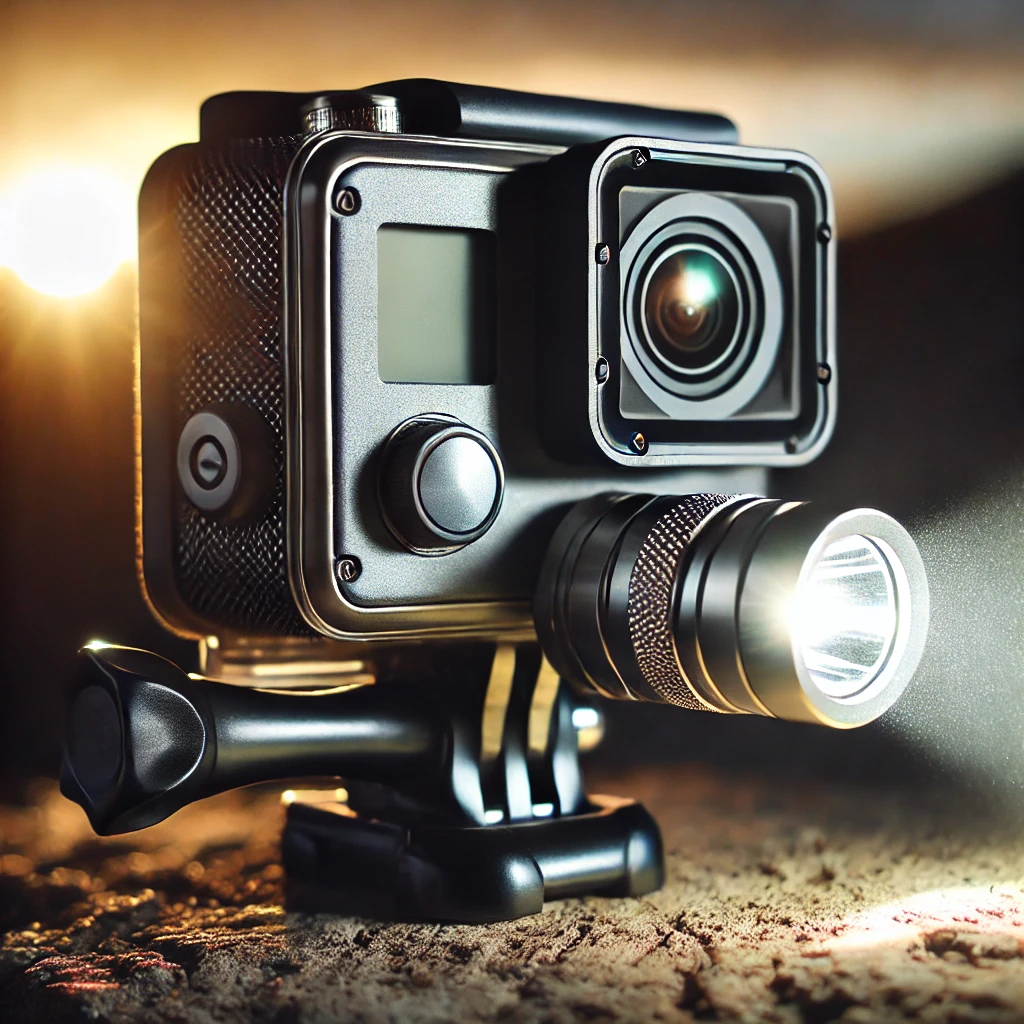Best Action Camera Flashlight 2024

Introduction: Action Camera Flashlight
An action camera flashlight is a useful accessory that can help brighten your surroundings, allowing you to capture clearer footage in low-light conditions. But it does more than just light up your shots—it also offers different lighting effects that can enhance the look of your videos.
This type of flashlight is designed specifically for action cameras to improve your filming in dark or dim environments. Unlike regular lights, action camera flashlights are compact and rugged, built to handle the rough conditions of outdoor activities like hiking, biking, or diving.
With features like adjustable brightness levels, these flashlights let you control how much light you need, helping to highlight your subject without overexposing it. Some models even offer special modes, like strobe or SOS, making them handy in emergencies.
While adding a flashlight to your camera setup may increase both the weight and cost, the results are usually well worth it. You’ll get better lighting, and your footage will look much clearer, even in tough conditions. Plus, some flashlights can be attached directly to the camera or used as handheld devices, giving you extra flexibility.
Thanks to advances in LED technology, these flashlights are bright yet energy-efficient, ensuring you capture every detail, whether you're filming on a mountain at sunset or underwater.
In this post, we'll go over what you should look for when buying an action camera flashlight and share some of the best options available on the market.
The action camera flashlight is a perfect blend of two important tools for outdoor enthusiasts and content creators. It combines the power and durability of an action camera with the bright illumination of a high-performance flashlight. With this tool, you can film your nighttime adventures or underwater explorations without needing separate lighting equipment.
Having an action camera flashlight in your gear collection not only opens up more creative possibilities but also boosts safety during nighttime activities. Whether you’re filming in the dark or in extreme conditions, this accessory ensures your footage stays clear and vibrant. And since the flashlight is built into the camera setup, it simplifies your gear and makes your experience even better, helping you capture those special moments, no matter how challenging the environment.
What to look for while buying an Action Camera Flashlight?
Things to Consider When Choosing an Action Camera Flashlight
When choosing the right action camera flashlight, there are a few key factors to keep in mind. These will help ensure you get the best light for your adventures and shooting needs.
Size and Weight
First, think about the size and weight of the flashlight. If you’re using a heavy, stationary camera that doesn’t need to move much, size and weight aren’t as important. However, since action cameras are designed to be lightweight and portable, these factors become much more important.
For action shots, you’ll want a flashlight that’s both compact and lightweight so it’s easy to carry and use without adding unnecessary bulk. This will allow you to move freely during your shoots, whether you're hiking, biking, or filming in fast-moving situations.
Battery Life
Next, consider the battery life. This is one of the most important aspects when choosing a camera flashlight because action cameras are often used outdoors where you might not have a nearby power source to recharge.
After all, what good is a flashlight if it runs out of power after just a few minutes? When shopping for a flashlight, pay attention to the battery life to ensure you get the most value for your money.
Most action camera flashlights use either AA or AAA batteries. AA batteries typically last longer than AAA, so if you need something that will keep going for a longer time, it’s a good idea to go with AA. However, AAA batteries are often cheaper, so they can be a more budget-friendly option if you’re watching your spending.
Keep in mind, though, that battery life can vary depending on a few factors. For example, AA batteries tend to last longer, but the size of the flashlight also plays a role. Smaller flashlights require less power, so they generally last longer on a single charge or set of batteries.
Price
Finally, consider the price of the flashlight. While you don’t want to spend a fortune, you also shouldn’t sacrifice quality just to save a few dollars. There are plenty of options available at different price points, so it’s worth taking the time to find the flashlight that offers the best balance of price and performance for your needs.
By keeping these factors in mind, you’ll be able to choose the best action camera flashlight that fits your budget and helps you capture amazing shots during all your outdoor adventures!
Best Action Camera Flashlight in the Market

Here are some of the top-rated action camera flashlights available today, each offering unique features to enhance your photography and videography.
1. G1s RGB Video Light
Features:
- 70pcs RGB color LED
- Built-in LCD display for accurate readings of temperature and color
- 360-degree rotating arm
- 150 minutes of operation at 100% brightness
The G1s RGB Video Light is a vibrant and colorful camera light designed to make your photos and videos more dynamic. With 70 RGB color LEDs, it offers up to 1500 Lux of illuminance and supports 4 modes and 12 lighting scene effects. The color temperature can be adjusted from 2500K (warm) to 8500K (cold), providing flexibility for various lighting situations.
It features a built-in LCD display, which gives you accurate readings of the temperature and color, making it easier to adjust settings for the perfect shot. The flashlight’s rotating arm with a cold shoe mount allows you to attach other accessories like microphones, which is ideal for recording videos.
With a full charge in just 2.5 hours, this light provides 150 minutes of operation at full brightness. The working time can be extended when the brightness is set below 100%.
2. Ulanzi Ultra Bright LED
Features:
- 49 Dimmable High Power LED
- Fits almost any Camera and Camcorder
- 2 AA batteries
- Average Lifetime: 500H
The Ulanzi Ultra Bright LED is a versatile and budget-friendly lighting solution for various photography needs. With 49 dimmable high-power LEDs, it provides stable, flicker-free lighting for macrophotography, product shoots, video recordings, and selfies. Its compact design fits most cameras, camcorders, and even smartphones.
This flashlight also features three shoe mounts, allowing you to connect multiple units to increase brightness and enhance your lighting setup. Despite long hours of use, it delivers consistent color temperature, and with a lifespan of up to 50,000 hours, it’s built to last.
3. Neewer 176 LED Video Light
Features:
- 176 High Power LED Bulbs
- Adjustable Color Temperature (3200K to 5600K)
- Wireless Remote Control
- Barn Doors for Precise Light Control
The Neewer 176 LED Video Light is a powerful tool for various filming environments. With 176 high-power LED bulbs, it offers adjustable color temperatures from 3200K (warm) to 5600K (cool), giving you flexibility for different lighting conditions.
This light also includes a wireless remote control, so you can adjust the brightness from a distance. The barn doors allow you to shape and direct the light, giving you more creative control over your shots. It’s perfect for interviews, vlogs, or studio lighting setups.
4. Aputure Amaran AL-M9
Features:
- 9 LED Panels with 5500K Color Temperature
- Compact and Lightweight Design
- Built-in Rechargeable Battery
- 9 Levels of Brightness
The Aputure Amaran AL-M9 is an incredibly compact and portable lighting solution. Featuring 9 LED panels with a 5500K color temperature, it provides daylight-balanced lighting to keep your shots natural and vibrant. This small but powerful light is ideal for photographers on the go.
With a built-in rechargeable battery, it can run for up to 60 minutes at maximum brightness. The light also offers 9 brightness levels, allowing you to adapt it to various environments, whether you’re filming outdoors or in low-light situations.
5. Godox LED64
Features:
- 64 High-Quality LED Bulbs
- Adjustable Brightness and Color Temperature (3300K to 5600K)
- Lightweight and Portable Design
- AC and Battery Powered Options
The Godox LED64 is a portable and versatile lighting solution with 64 high-quality LED bulbs. It offers adjustable brightness and color temperature, ranging from 3300K to 5600K, to suit various shooting conditions. Whether you’re indoors or outdoors, this light provides flexibility with both battery and AC power options.
Its lightweight design makes it easy to carry, and it’s perfect for any type of shoot, whether you're filming video, taking photos, or shooting content for social media.
The Action Camera Flashlight: A Dual-Purpose Marvel
In the world of adventure photography and videography, the action camera flashlight is changing the game for how enthusiasts capture and light up their experiences. Here’s why this innovative tool is so special:
Seamless Integration
- It combines both an action camera and a flashlight into one device.
- This means you don’t need to carry around separate equipment, cutting down on bulk and simplifying your gear.
Enhanced Versatility
- Perfect for shooting in low-light or even total darkness.
- It’s great for activities like night hiking, underwater filming, and exploring caves.
Improved Illumination
- With high-lumen LEDs, this flashlight offers bright, consistent lighting.
- It ensures your videos are clear and vibrant, even in tough lighting conditions.
Durable Design
- Built to handle rough environments, it’s water-resistant and shockproof.
- Perfect for outdoor enthusiasts who need reliable gear in extreme conditions.
Convenient Operation
- Switch easily between camera and flashlight modes.
- Often includes intuitive controls and adjustable settings for both light intensity and camera functions.
Compact and Portable
- Lightweight and easy to pack, it fits comfortably in your backpack or gear bag.
- Streamlines your travel and packing, making it an essential tool for adventurers.
Enhanced Safety
- Increases visibility in dark or hazardous environments, improving safety during your activities.
- It’s also helpful for signaling or navigating in low-visibility situations.
Innovative Technology
- Some models come with advanced features like stabilization, HD recording, and different shooting modes.
- Incorporates the latest tech for capturing high-quality images and videos on the go.
The action camera flashlight is a versatile, all-in-one tool that combines lighting and imaging to make your nighttime adventures easier and more enjoyable. Whether you’re exploring new places or capturing stunning footage, it’s a must-have for anyone who likes to explore the world after dark.

Action Camera Flashlight FAQs
1.) Do action cameras have flash?
Most action cameras do not come with a built-in flash. Instead, they are designed to perform well in low-light conditions, relying on their high-quality sensors. However, if you need extra lighting for your shots, you can always add an external flashlight specifically designed for action cameras.
2.) What is the flashlight in a camera?
The flashlight in a camera, commonly referred to as a "flash," is a built-in light source that provides illumination when taking photos in low-light settings. It helps to brighten the scene, reduce motion blur, and enhance the details of your photos. In action cameras, however, external flashlights are often preferred, as they offer better lighting for dynamic, fast-moving shots.
3.) How do I choose a camera flashlight?
When selecting a camera flashlight for your action camera, keep these factors in mind:
- Brightness: Check the lumen rating; the higher the lumens, the brighter the light.
- Battery Life: Look for a flashlight with long battery life to support longer shooting sessions.
- Water Resistance: Opt for a waterproof or weather-resistant flashlight if you’re using it for outdoor activities.
- Mounting Options: Ensure that the flashlight is easy to attach to your action camera.
- Adjustable Settings: Features like adjustable brightness and strobe modes can make the flashlight more versatile for different shooting scenarios.
Choose a flashlight that fits your specific needs and complements your style of shooting!
4.) What are the disadvantages of action cameras?
Although action cameras are perfect for capturing action-packed footage, they do have a few downsides:
- Limited Battery Life: Action cameras often have shorter battery life, especially when using features like Wi-Fi or shooting in high resolutions.
- Small Sensor Size: The smaller sensor size can affect low-light performance and overall image quality.
- No Optical Zoom: Most action cameras lack optical zoom, which limits your framing options.
- Fixed Lens: Action cameras typically come with a fixed wide-angle lens, which can cause distortion at the edges of the frame.
- Limited Manual Control: Action cameras usually have fewer manual settings compared to traditional cameras, making it harder to fine-tune your shots.
Understanding these limitations will help you decide if an action camera is right for your needs.
5.) How to use a camera flashlight?
To get the best out of your camera flashlight, follow these simple steps:
- Attach the Flashlight: Mount the flashlight securely to your action camera using compatible brackets or mounts.
- Power On: Turn on the flashlight and check the battery level to make sure it’s ready for use.
- Adjust Settings: If the flashlight has adjustable brightness or different modes (like strobe), set it according to your shooting environment.
- Position the Flashlight: Aim the flashlight at your subject, but avoid directing the light straight into the camera lens to prevent glare.
- Test Shots: Take a few test shots to check the lighting and make any necessary adjustments.
By following these steps, you can improve your low-light photography and achieve better results!
6.) What color is best for a flashlight?
The best flashlight color depends on the situation:
- White Light: Ideal for general use as it provides true-to-life color representation. It's great for most photography and videography tasks.
- Warm White (Yellow): This creates a softer, natural look and is often used in portrait photography or indoor settings.
- Red Light: Perfect for preserving night vision, making it useful for wildlife photography or when you want to avoid startling your subject in low-light conditions.
- Blue/Green Light: These can help enhance contrast in specific situations, though they are less commonly used for general purposes.
Choose the color that best fits your shooting environment and the effect you want to create!
7.) What is the difference between DSLR and action cameras?
DSLRs and action cameras are designed for different purposes. Here are the key differences:
- Design and Size: DSLRs are larger and bulkier, while action cameras are compact and lightweight for easy portability.
- Image Quality: DSLRs usually have larger sensors, which produce better image quality, especially in low light. Action cameras typically have smaller sensors.
- Lens Options: DSLRs allow you to change lenses for more flexibility, while action cameras usually have a fixed wide-angle lens.
- Shooting Modes: DSLRs offer more manual controls, while action cameras are designed for simplicity and ease of use.
- Durability: Action cameras are built to withstand extreme conditions, and they’re often waterproof, while DSLRs need additional protective gear.
Choose based on what fits your specific needs and shooting environment!
8.) What is the difference between action camera and video camera?
The main differences between action cameras and video cameras include:
- Design and Portability: Action cameras are compact and rugged, perfect for extreme conditions, while video cameras are typically larger and designed for stability.
- Shooting Styles: Action cameras excel at capturing wide-angle shots in motion, while video cameras are better suited for interviews, traditional filming, and cinematic projects.
- Mounting Options: Action cameras can be mounted on helmets, bikes, or drones, whereas video cameras require tripods or stabilizers.
- User Interface: Action cameras are often simpler to use, whereas video cameras offer more advanced controls and settings.
- Audio Quality: Video cameras generally provide better built-in microphones and external audio options, while action cameras often require external microphones for better sound.
Choose based on the type of shooting you’ll be doing!
9.) Can you use an action camera as a normal camera?
Yes, you can use an action camera as a normal camera! While action cameras are designed to capture action and movement in challenging environments, they can also take still photos and record videos in everyday settings. Their compact size, ease of use, and wide-angle lens make them versatile for various situations. Just keep in mind that they may lack certain features like optical zoom and manual settings found in traditional cameras.
10.) Can you use your phone as an action camera?
Yes, you can use your phone as an action camera! Many modern smartphones come with high-quality cameras and features that can handle video and photo shooting in various conditions. To improve your phone’s performance for action shots:
- Use a Stabilizer: A gimbal or stabilizer can help eliminate shaky footage during fast-paced shots.
- Mounting Options: You can find mounts and accessories to attach your phone to bikes, helmets, or other gear.
- Waterproof Cases: If you plan to shoot in wet conditions, a waterproof case is essential.
- Apps: Use specialized camera apps for better control over settings and features.
Although phones aren’t as rugged as dedicated action cameras, with the right accessories, they can still capture incredible action-packed moments!
More From The Corner Best Action Camera Flashlight Best Practices for Maintaining Image Quality During Conversion The Impact of Image Format on Website Performance: Why Conversion Matters Image Conversion for Social Media: Tools and Tips for Perfectly Sized Images Batch Image Conversion: Techniques and Tools for Handling Large Volumes Understanding Lossy vs. Lossless Image Conversion: What You Need to Know
